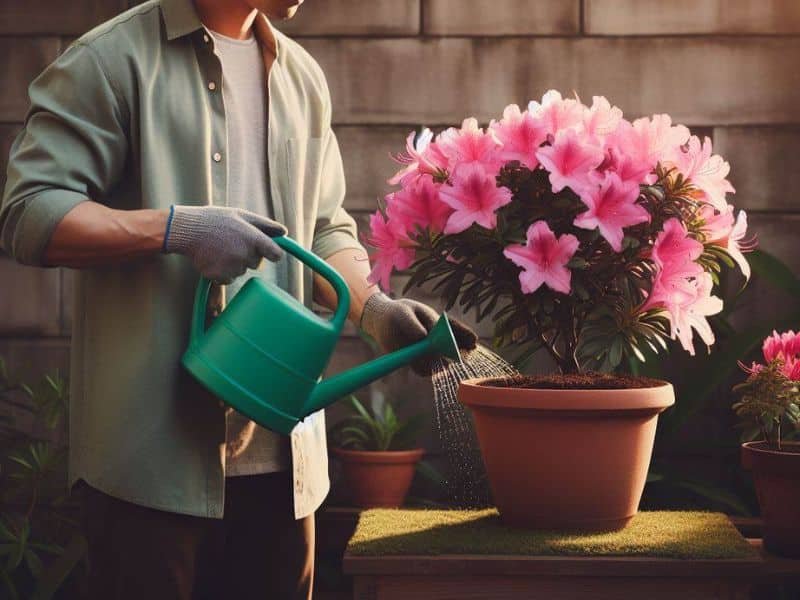You’ve lovingly tended to your azalea, ensuring it has everything it needs to thrive. Yet, despite your best efforts, you notice its leaves turning yellow, its vibrant blooms wilting.
Could your well-intentioned care be doing more harm than good? Overwatering is a common yet often overlooked issue that can lead to serious problems for your azalea. Recognizing the signs early can be the key to saving your plant and restoring its health.
Understanding the balance between too much and just enough water is crucial for the well-being of your azalea. In this article, we’ll delve into the causes of overwatering, how to identify its telltale signs, and, most importantly, how to rectify the situation.
Armed with the right knowledge, you’ll be equipped to nurse your azalea back to its former glory, ensuring it remains a stunning addition to your garden. Let’s explore how to tackle overwatering, ensuring your azalea thrives for seasons to come.
Recognizing Overwatered Azalea
When caring for your azalea, noticing the balance between too much and just enough water is key to keeping it thriving. Let’s dive into what you should keep an eye out for.
Signs and Symptoms
Yellowing leaves may well be the first clue that your azalea is waving a distress flag due to overwatering. Not far behind, you’ll see a lack of leaf growth or leaves that are more brown than green, signaling that your plant is definitely in trouble.
If the soil feels soggy or if there’s standing water at the base, it’s a clear indicator that it’s time to ease up on the watering can. These symptoms signal that the roots may be struggling to breathe and absorb nutrients effectively, a situation you’ll want to rectify swiftly to avoid long-term harm.
Comparing Healthy Vs. Stressed Plants
A healthy azalea boasts vibrant green leaves, strong stems, and a robust bloom during its flowering season. The soil should be moist but not waterlogged, ensuring the roots have the perfect environment to absorb water and nutrients.
In contrast, an overwatered azalea appears wilted, with yellow or brown leaves that often detach easily. The stems may look weak, and the plant’s overall vigor declines.
This comparison not only highlights the importance of proper watering but also demonstrates the critical balance necessary for your azalea’s health and blooms. Recognizing these signs early can turn the tide, transforming a stressed plant back into the flourishing beauty that is a highlight of your garden.
Causes of Overwatering in Azaleas

Environmental Factors
Overwatering azaleas often result from an oversight of environmental conditions. High humidity levels combined with cool temperatures can reduce the plant’s water usage, leading to waterlogged soil.
Similarly, poor drainage in the planting area exacerbates the retention of excess water around the roots, creating conditions ripe for overwatering issues. Addressing these environmental factors is key, as they play a significant role in water management for azaleas.
Irrigation Mistakes
Frequent watering mistakes play a pivotal role in overwatering azaleas. An overly enthusiastic watering routine, not adjusted for rainfall or specific plant needs, often leads to overwatering. Remember, azaleas prefer a drink when their soil is slightly dry, not a constant swim.
Equally troublesome are irrigation systems set to a one-size-fits-all schedule, ignoring the unique watering needs of azaleas compared to other garden plants. Calibration of watering habits to match the azalea’s requirements will prevent overwatering and promote a healthy garden.
Consequences of Overwatering

Maintaining the correct water balance for azaleas is critical to their survival and bloom vibrancy. The discussion now shifts to the adverse outcomes of overwatering these plants.
Root Rot and Fungal Issues
Overwatering azaleas creates an environment where root rot thrives. This condition stems from a lack of oxygen, as waterlogged soil prevents roots from breathing. Affected azaleas show weakened, brown roots instead of healthy white ones.
Additionally, damp conditions encourage the growth of harmful fungi, further compromising plant health. Quick action is necessary to address these issues, as they can lead to the plant’s demise if untreated.
Plant and Flower Health Decline
Excess water doesn’t just trouble the roots; it impacts the entire plant. Azaleas suffering from overwatering exhibit droopy, yellow leaves, a telltale sign of distress.
Flower production also takes a hit, with blooms appearing lackluster or failing to develop at all. Adjusting your watering regimen is key to reviving the plant’s health and ensuring the production of those iconic azalea blooms you cherish.
Rescuing an Overwatered Azalea
Steps for Recovery
Rescuing your overwatered azalea begins with assessing the extent of water damage.
First, cut back any visibly damaged roots or foliage to prevent further stress on the plant. If the damage is severe, don’t hesitate; remove all affected areas.
Next, allow the soil to dry out naturally by reducing your watering schedule significantly. This step is crucial, promoting a dry environment helps the roots recover and prevents fungal growth.
Lastly, introduce a well-draining soil mix if necessary and consider aeration techniques to improve soil structure and drainage.
When to Repot
Deciding to repot your azalea is a decision that comes with observation. If you notice the soil remains waterlogged for days or the plant shows no sign of recovery, it’s time to repot. Choose a pot one size larger with adequate drainage holes to give your azalea room to breathe.
When repotting, gently tease out the roots to encourage new growth and ensure the new soil is specifically designed for azaleas, as they thrive in slightly acidic conditions. This careful transition can give your plant a fresh start, laying the foundation for vibrant blooms and a thriving azalea.
Prevention Tips for Azalea Care
Keeping your azaleas healthy and blooming isn’t rocket science, but it does call for some attention to detail, especially when it comes to water and soil management. Remember, too much love in the form of water can spell disaster for these vibrant plants.
Proper Watering Techniques
How you water your azaleas can make or break their health. First off, let’s kill the myth of a one-size-fits-all watering schedule. Your azaleas’ thirst depends on various factors such as weather, soil type, and plant size.
During hot, dry periods, azaleas demand more water, but they like to take a breather in cooler or rainy spells. Aim for a Goldilocks approach— not too much, not too little.
The golden rule? Water deeply but infrequently. This practice encourages the roots to grow deeper, making them sturdy and resilient.
A good soak once a week should suffice, adjusting based on the weather and soil dryness. Always check the soil before reaching for that watering can; if it’s moist an inch below the surface, your azalea is just fine without extra water.
Soil and Drainage Considerations
Next up, let’s talk dirt, or more more precisely, the type of soil that makes azaleas thrive. These plants love well-drained, slightly acidic soil. Poor drainage is often the culprit behind waterlogging, leading to distressed plants with root problems.
To keep your soil’s drainage on point, mixing in organic materials like pine bark or compost can boost its structure and water-handling capabilities. If you find your garden has heavy clay soil, consider raising your azaleas in raised beds or containers. This gives you full control over the soil mixture, ensuring it drains well and keeps root rot at bay.
Remember, a happy azalea is all about balance— the right amount of water and good soil to call home. Keep these tips in mind, and your azaleas will thank you with stunning blooms and robust health.







